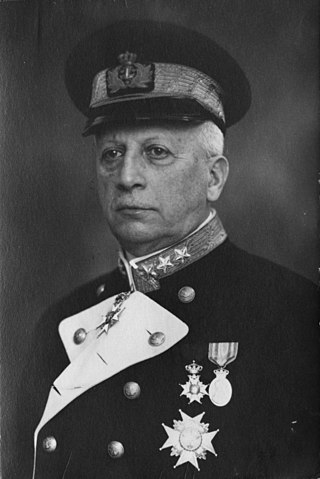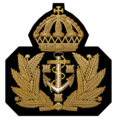Admiral is a four-star commissioned naval officer rank in the Swedish Navy. Admiral ranks immediately above vice admiral and is equivalent to general.
Fänrik is a company grade officer rank. In the army/airforce, it ranks above sergeant and below lieutenant. In the navy, it ranks above sergeant and below sub-lieutenant. It is equivalent to the specialist officers rank of översergeant. Fänrik means standard-bearer and has been used as a name for the lowest officer rank in the Swedish infantry since the 16th century, with the exception of the years 1835–1914.
Löjtnant is a company grade officer rank. In the army/airforce, it ranks above second lieutenant and below captain. In the navy, it ranks above acting sub-lieutenant and below lieutenant. It is equivalent to the specialist officers rank of förvaltare. The rank has been used in Sweden since the Middle Ages.
Kapten is a company grade officer rank. In the army/airforce, it ranks above lieutenant and below major. In the navy, it ranks above sub-lieutenant and below lieutenant commander. It is equivalent to the specialist officers rank of förvaltare. The rank has been used in Sweden since the Middle Ages.
Major (Maj) (Swedish: Major, Mj) is a field grade military officer rank in the Swedish Armed Forces, above the rank of captain and below the rank of lieutenant colonel. It is equivalent to the naval rank of lieutenant commander in the Swedish Navy.
Lieutenant colonel (LtCol) (Swedish: Överstelöjtnant, Övlt) is a field grade officer rank in the Swedish Armed Forces, just above the rank of major and just below the rank of colonel. It is equivalent to the naval rank of commander in the Swedish Navy.
Colonel (Col) (Swedish: överste, öv) is the most senior field grade military officer rank in the Swedish Army and the Swedish Air Force, immediately above the rank of lieutenant colonel and just below the rank of brigadier general. It is equivalent to the naval rank of captain in the Swedish Navy.
Brigadier General (BGen) (Swedish: Brigadgeneral, Bgen) is a one-star commissioned officer rank in the Swedish Army, Swedish Air Force and Swedish Amphibious Corps. A Brigadier general ranks immediately above a colonel and below a major general. The rank is equivalent to rear admiral (lower half) in the Swedish Navy.
Major General (MajGen) (Swedish: generalmajor, genmj) is a two-star commissioned officer rank in the Swedish Army, Swedish Air Force and Swedish Amphibious Corps. Major general ranks immediately above brigadier general and below a lieutenant general. The rank is equivalent to rear admiral in the Swedish Navy.
Lieutenant General (LtGen) (Swedish: generallöjtnant, genlt) is a three-star commissioned officer rank in the Swedish Army, Swedish Air Force and Swedish Amphibious Corps. Lieutenant general ranks immediately above major general and below a general. The rank is equivalent to vice admiral in the Swedish Navy.
General is a four-star commissioned officer rank in the Swedish Army, Swedish Air Force and Swedish Amphibious Corps. General ranks immediately above lieutenant general and is equivalent to admiral in the Swedish Navy. It is held by the Supreme Commander of the Swedish Armed Forces and the monarch.

The Coastal Fleet was until 1994 a Swedish Navy authority with the main task of training the naval ships commanders and crews. After the formation of the authority Swedish Armed Forces in 1994, the Coastal Fleet remained as a unit until 2000.

Admiral Otto Emil Lybeck was a Swedish Navy officer. Lybeck's senior commands include Minister of Defence, Commander-in-Chief of the Coastal Fleet and Chief of the Naval Staff.
Vice admiral is a three-star commissioned naval officer rank in the Swedish Navy. Vice admiral ranks above rear admiral and below admiral. Vice admiral is equivalent to the rank of lieutenant general.
Rear admiral (lower half), abbreviated RAdm (Swedish: Flottiljamiral, Fljam; lit. 'flotilla admiral') is a one-star flag officer in the Swedish Navy. Rear admiral (lower half) ranks above captain and below rear admiral. The rank is equivalent to brigadier general in the Swedish Army, Swedish Air Force and the Swedish Amphibious Corps.
Kommendör, abbreviated kmd is the most senior rank of commissioned officer below that of flag officer in the Swedish Navy, ranking below rear admiral and above commander. The rank is equivalent to colonel in the Swedish Army, Swedish Air Force and the Swedish Amphibious Corps.
Kommendör av 1. graden was a senior captain rank of the Swedish Navy, ranking below rear admiral (1972–2000) and rear admiral, and above captain.
Commander (Cdr) (Swedish: Kommendörkapten, Kk) is a senior-grade officer rank in the Swedish Navy, ranking below captain and above lieutenant commander. The rank is equivalent to lieutenant colonel in the Swedish Army, Swedish Air Force and the Swedish Amphibious Corps. Before 1972, the rank of commander was divided into two ranks: commander (kommendörkapten av 1:a graden/klassen) and lieutenant commander (kommendörkapten av 2:a graden/klassen).
Lieutenant commander (LtCdr) (Swedish: Örlogskapten, Örlkn) is a mid-ranking officer rank in the Swedish Navy. Lieutenant commanders rank above lieutenants and below commanders, and rank is equivalent to a major in the Swedish Army, Swedish Air Force and the Swedish Amphibious Corps. Before 1972, the rank of örlogskapten was called kommendörkapten av 2:a graden/klassen.
The Fleet Staff was a staff in the Swedish Navy created in 1884, that corresponded to the General Staff in the Swedish Army. It consisted of a commander with the rank of flag officer or captain, as well as a number of officers from the Swedish Navy and the Swedish Coastal Artillery, who were assigned to serve on the staff. The Fleet Staff's tasks included developing plans for the mobilization of the navy and handling issues related to the maintenance and use of naval forces; monitoring and proposing training and exercises for the personnel; monitoring the development of naval warfare both within and outside the country; conducting research in naval warfare history, drafting necessary regulations, and similar tasks; and conducting investigations in maritime military matters. The Fleet Staff was renamed on 31 December 1907 and became the Naval Staff.


















